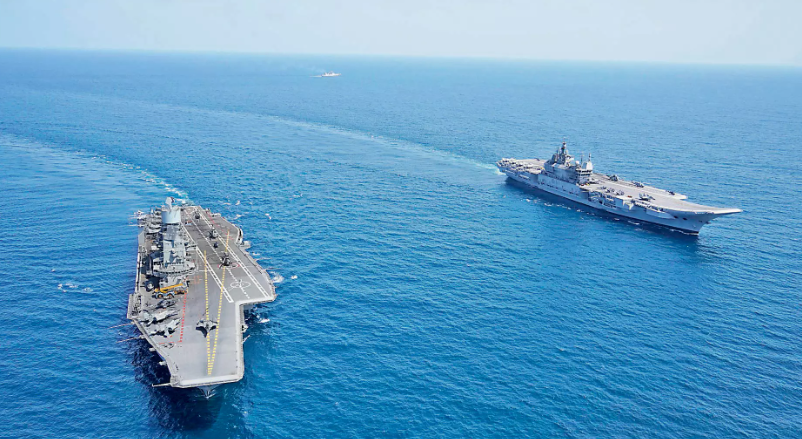Technology Perspective and Capability Roadmap (TPCR) 2025

- 12 Sep 2025
In News:
- The Ministry of Defence (MoD) recently released the Technology Perspective and Capability Roadmap (TPCR) 2025, a strategic blueprint outlining India’s defence technology and capability requirements over the next 15 years.
- The roadmap aims to guide the Indian Army, Navy, and Air Force in modernisation while providing domestic industry, academia, and research institutions early visibility to align R&D and production with future procurement needs. Indigenisation and self-reliance form the core of TPCR 2025.
Objectives of TPCR 2025
- Early Visibility for Industry: Help domestic manufacturers and research organisations plan development and production of advanced defence systems.
- Indigenisation: Reduce dependence on imports and promote domestic defence manufacturing.
- Future-Ready Armed Forces: Equip the military to face multi-domain warfare challenges, including cyber, space, AI-enabled, and hybrid conflicts.
- Sustainability: Integration of green logistics and energy-efficient systems in defence operations.
Key Features by Service
Navy:
- Nuclear Propulsion: Plans to induct 10 nuclear propulsion systems for aircraft carriers and large surface combatants, providing virtually unlimited endurance at sea.
- Next-Generation Aircraft Carrier: Equipped with Electromagnetic Aircraft Launch System (EMALS) to launch heavy fighters, airborne early warning aircraft, and UAVs in all sea states. Digital twin simulations to enable predictive maintenance.
- Surface Combatants: Induction of 5–10 destroyers, 7 corvettes, 4 Landing Platform Docks (LPDs) (~29,000 tonnes each), and 100 Next Generation Fast Interceptor Craft for coastal security.
- Underwater Warfare: 20 high-endurance Autonomous Underwater Vehicles (AUVs) for long-range surveillance and mine countermeasures.
- Missiles & Weapons: Over 200 surface-to-surface missiles and universal launchers for multi-platform deployment.
Army:
- ArmouredModernisation: Replacement of ageing T-72 fleet with 1,800 Future Ready Combat Vehicles (FRCVs); 300–400 light tanks for high-altitude sectors.
- Anti-Tank and Precision Weapons: Procurement of 50,000 ATGMs with tandem HEAT warheads, along with 600,000 artillery rounds, emphasising precision-guided munitions.
- UAV & Robotic Systems: Deployment of 70 MALE/HALE UAVs, 800 integrated drone-loitering munitions systems, and 400 ultra-light missiles for UAVs; over 700 robotic counter-IED systems.
- Cyber & AI Warfare: AI-enabled detection, classification, and adaptive jammers creating 15 km electronic denial zones; deepfake detection tools for operational security.
Air Force:
- Directed-Energy Weapons: 10–15 Tactical High-Energy Laser (THEL) systems with ranges of 6–15 km; high-power microwave systems to neutralise incoming threats.
- Stealth and UAVs: 150 stealth bomber drones for deep-strike missions; 100+ remotely piloted aircraft for ISR and strike roles.
- Persistent Surveillance: 75 High-Altitude Pseudo-Satellites (HAPS) and 20 stratospheric airships for continuous ISR and communications over extended periods.
Tri-Services (Joint):
- Hypersonic Missiles: Induction of 500+ scramjet-propelled hypersonic missiles capable of Mach 5+ speeds for rapid strike across land, sea, and air.
- Universal Missile Launchers: Platforms for multiple missile types to ensure interoperability.
- Cyber-Space Preparedness: AI-as-a-service platforms for 4,000 users, quantum key distribution networks, satellite hardening, and post-quantum secure communications.
Cross-Cutting Technologies
- AI & ML: Smart, predictive warfare through digital twin simulations and autonomous systems.
- Hybrid Warfare Capability: Integration of unmanned systems, robotic tools, and precision-guided munitions.
- Green & Sustainable Defence: Energy-efficient platforms and logistics aligned with national sustainability goals.
Strategic Significance
TPCR 2025 positions India to:
- Achieve self-reliance in defence technologies.
- Maintain credible deterrence and modernisation across all domains.
- Address emerging threats in cyber, space, and multi-domain warfare environments.
- Strengthen domestic defence industrial base through early technology visibility.
